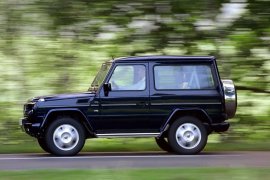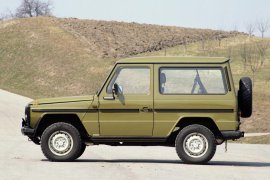MERCEDES BENZ G-Klasse Kurz Models/Series Timeline, Specifications & Photos
First production year: 1979
Engines: Diesel, Gasoline
Body style: SUV (Sports Utility Vehicle)
In 2000, at the Paris Motor Show, Mercedes-Benz unveiled the refreshed W463 G-Class, which came in three types of bodywork, including the three-door version.
While the star of the sales by 2000 for the W463 G-Class was the five-door version, the three-door was the one that topped in terms of off-road abilities. Thanks to its short wheelbase and the better power-to-weight ratio, it was chosen by many. Mercedes-Benz also knew that its customers didn't complain about the SUV's appearance or off-road performance. On the other hand, there were many requests to improve the road behavior, the transmission, and the interior. As a result, the German car manufacturer worked mostly in these areas. At the same time, it couldn't leave the exterior untouched, so it tweaked it a bit here and there, mostly to make it appear fresh. Furthermore, it improved the safety systems and added several features that were unavailable before this 2001 model-year version.
From its front side, the three-door version had the same rugged look as its five-door sibling. It featured a new, three-slat plastic grille that supported the automaker's center-mounted badge. On the sides, in individual casings, the automaker placed the round headlights. Even though it had enough room to install the turn signals and parking lights, it preferred to leave those in the same spot as before, on top of the front fenders. These were already a known trademark of the vehicle. The new plastic (ABS) bumper could be optioned with rectangular fog lamps.
From its profile, the short-wheelbase version of the G-Class was available as a three-door station wagon or as a two-door convertible. Starting with this version, the G-Class got body-colored flared wheel arches and door mirror caps. Furthermore, Mercedes-Benz installed turn signals on the door mirror's caps, enhancing the vehicle's safety. Depending on the grade and options, the car could be optioned with side steps that ease ingress and egress. At the back, the side-hinged rear door allowed access to the tiny trunk and mostly served as a support for the full-size spare wheel.
Mercedes-Benz redesigned the car's interior. It created a new dashboard, which featured an instrument cluster that resembled the one installed in the C-Class (the W203). It had a large, center-mounted speedometer flanked by the tachometer on the left and the fuel level gauge on the right. Surprisingly, the coolant temperature wasn't shown on the main dials, so the driver had to find the reading on the car's onboard computer on a small screen fitted inside the speedometer's dial. To do that, it had to use the buttons on the steering wheel, which looked like it was carried over from an E-Class (the W210). On the center stack, the automaker placed the new COMAND infotainment unit, which included navigation and was available with phone connectivity. Customers could get the car with wood trims on the dash, leather upholstery, and heated front seats. Those seated in the back, on the other hand, didn't have enough legroom.
Under the hood, the automaker installed a range of Euro 3-compliant gasoline or turbodiesel engines. All were paired with a newly developed five-speed automatic transmission, also known as the 5G-Tronic. The high and low-range transfer boxes sent power in all corners via three manual-locking differentials. Mercedes-Benz tried to improve road handling by re-tuning suspension and dampers, although the vehicle's base was still the same sturdy, off-road-oriented, ladder-frame chassis.
A decade after the introduction of the W460 G-Class by Mercedes-Benz, the German automaker launched a second generation of it, known as the W463, which was also available in three body shapes.
The G-Class's reputation grew consistently during its ten-year evolution on the market. Besides being an amazing off-road machine, it proved to be a trustworthy vehicle. But its customers often complained about the vehicle's poor on-road abilities and the lack of many comfort features. Even though it was fitted with AC in the early '80s and gained some amenities, it couldn't hide its utilitarian-oriented on-road behavior. Furthermore, the G-Class was far behind the rest of the automaker's range in luxurious items. That's why, in the mid-80s, Mercedes-Benz started to develop the vehicle and improve it in key areas. However, there was one significant part in which customers didn't ask for any changes in the exterior design. As a result, both the three-door and the five-door versions looked very similar to the W460, but they were not identical. Like the previous model, the three-door version was built on top of the short wheelbase chassis and represented the access model in the G-Class family.
At the front, the car gained a new front fascia that was body-colored. Its rectangular grille with horizontal slats was flanked by big and round headlights. Even though the automaker could find a different place to install the blinkers and the parking lights, it still kept them on top of the front fenders, like on the W460. Furthermore, the automaker created a new bumper that could be optioned with a pair of rectangular fog lamps integrated into it.
From its profile, the three-door version kept the same rugged look with its exposed door hinges. The automaker offered the car with new alloy wheels and more color options for the bodywork. In addition, the wheel arches were adorned with wider plastic trims that kept the vehicle cleaner. At the back, the automaker kept the same style for the side-hinged rear door where it mounted the spare wheel. The rear bumper was also thick and integrated the reversing light and the fog lamp.
Mercedes-Benz started rebuilding the car's interior from an empty shell. Nothing was carried over from the W460 model. The leather upholstery and the power windows also became available. The dashboard was still flat and narrow. However, it featured a new instrument cluster that was wider and shaped similarly to the one from the E-Class (the W124). The speedometer took center stage inside it and was flanked by the fuel level and temperature gauges, while the right dial was for the tachometer. On the center stack, the automaker placed wood trims and the buttons for the three locking differentials. Lower, customers could find the HVAC control unit and the stereo. Between the front seats, the automaker placed a wide center console that housed the gear stick or the gear selector, depending on the option, and the lever for the transfer case. While the front passengers could enjoy some level of comfort, legroom in the back was cramped. The split-folding (60/40) bench seat could hardly provide enough room for three adults.
Under the hood, the automaker installed a choice of diesel and gasoline engines paired with either a five-speed or four-speed automatic. Unlike its predecessor, the W463 was an all-wheel drive vehicle. Mercedes-Benz also re-tuned the coil-spring suspension for improved comfort. Further technical advancements included three locking differentials, ABS and ESP, for specific versions.
MERCEDES BENZ G-Klasse Kurz (W463) 200 GE 5MT AWD (118 HP)
MERCEDES BENZ G-Klasse Kurz (W463) 230 GE 5MT AWD (126 HP)
MERCEDES BENZ G-Klasse Kurz (W463) 300 GE 5MT AWD (170 HP)
MERCEDES BENZ G-Klasse Kurz (W463) G 320 (L6) 4AT AWD (210 HP)
MERCEDES BENZ G-Klasse Kurz (W463) G 320 (V6) 5AT AWD (215 HP)
MERCEDES BENZ G-Klasse Kurz (W463) G 500 V8 5AT AWD (296 HP)
There are not as many iconic cars as the Mercedes-Benz G-Class, a vehicle that redefined the off-road vehicle industry in the late ‘70s when the German automaker launched it on the market.
Usually, iconic vehicles have a unique history behind them, and so does the G-Class from Mercedes-Benz. The story says that the car was ordered by the Shah of Iran, Mohammad Reza Pahlavi, who needed a go-anywhere vehicle for the army. Since he was also a major stakeholder in Mercedes-Benz, he convinced the carmaker’s board to create one. The study started in 1972, and the German car manufacturer partnered with the Austrian company Steyr to produce it. Seven years later, the SUV was ready, and the automaker produced it with either a short or a long wheelbase. The short one was available in a three-door configuration, as a convertible, or as a panel van. Furthermore, the automaker could supply the W460 as a chassis cab. But the one element that made it so unforgettable was the vehicle’s squared shape. It was a true form-follow-function vehicle that lasted.
At the front, the automaker’s design team considered that an off-road vehicle needed to have short overhangs. That led to a flat front fascia, where the black grille was flanked by upper-mounted round headlights. Above them, the automaker installed the turn signals and parking lights on top of the fenders, flanking the V-shaped hood.
From its profile, the flat panels of the vehicle sported a longitudinal trim, which was interrupted only by the grab-type door handles. To create an even sturdier look, the automaker left the doors’ hinges exposed. Nevertheless, this solution was also cheaper to manufacture, and the vehicle was already very expensive then. Behind the door, the automaker installed wide windows or a retractable canvas roof for the civilian version. The utilitarian version was fitted with metallic panels. Finally, at the back, the G-Class short featured a side-hinged door where the car manufacturer placed the spare wheel.
Inside, the utilitarian look of the vehicle was unmistakable. The fabric upholstery and the scarce design left no doubt that it was a car designed to do a job, not to transport its occupants comfortably. But still, Mercedes-Benz tried to provide its customers with some comfort amenities. As a result, the driver fronted a small instrument cluster that was filled by three dials. The one on the left was for the speedometer, the one in the middle for the rev counter, and the one on the right housed the coolant temperature and the fuel level gauges. On the center stack, the automaker placed a stereo, an ashtray, and the controls for the heating system. While the front occupants sat in comfort, those in the back had limited legroom.
But the real marvel was under the car’s skin. Mercedes-Benz installed a choice of four engines that were already in production for other models. There were two gasoline and two turbo diesel versions. All were paired with a four or a five-speed manual or with an automatic gearbox. Both axles were fitted with locking differentials, which the driver could control from inside the vehicle via two levers that could lock them.
MERCEDES BENZ G-Klasse Kurz (W460/461) 200 GE (G-Kat) 4MT AWD (118 HP)
MERCEDES BENZ G-Klasse Kurz (W460/461) 200 GE 4MT AWD (122 HP)
MERCEDES BENZ G-Klasse Kurz (W460/461) 230 G 4MT AWD (109 HP)
MERCEDES BENZ G-Klasse Kurz (W460/461) 230 GE (G-Kat) 4MT AWD (122 HP)
MERCEDES BENZ G-Klasse Kurz (W460/461) 230 GE 4MT AWD (125 HP)
MERCEDES BENZ G-Klasse Kurz (W460/461) 280 GE 4MT AWD (156 HP)
MERCEDES BENZ G-Klasse Kurz (W460/461) 240 GD 4MT AWD (72 HP)
MERCEDES BENZ G-Klasse Kurz (W460/461) 250 GD 4MT AWD (84 HP)
MERCEDES BENZ G-Klasse Kurz (W460/461) 290 GD 5MT AWD (95 HP)
MERCEDES BENZ G-Klasse Kurz (W460/461) 290 GD Turbodiesel 4AT AWD (120 HP)
MERCEDES BENZ G-Klasse Kurz (W460/461) 300 GD 4MT AWD (88 HP)


